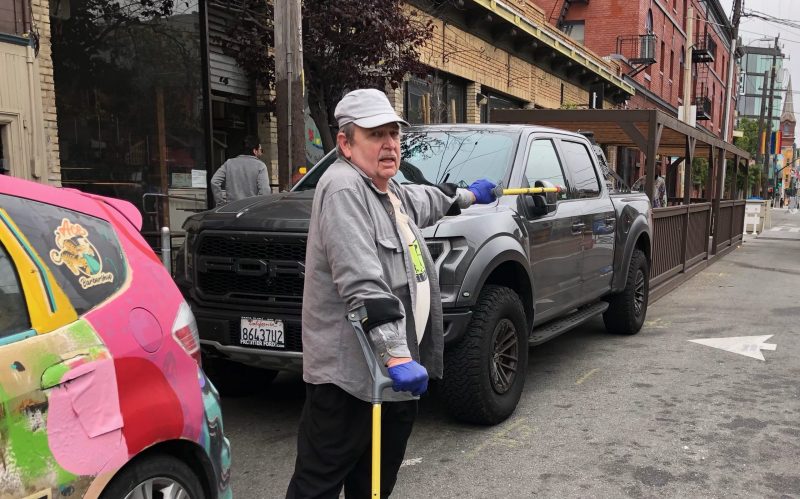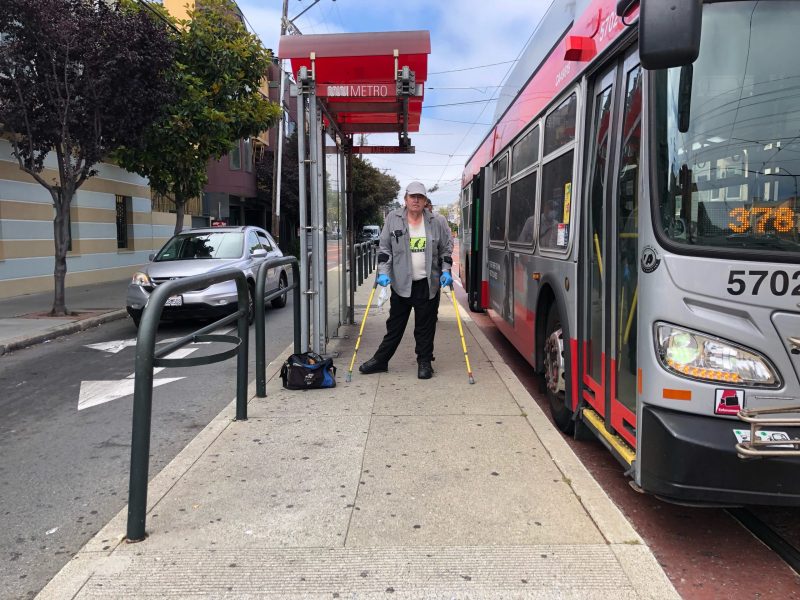Parklets are the latest focus of veteran San Francisco transit activist, who highlights barriers to seniors and those with disabilities
A friend said that to understand activist Bob Planthold one might be best advised to start by watching “Crip Camp,” the film backed by the Obamas’ Higher Ground Productions that documents the rise of the disability rights movement.
With its theme of “Nothing about us without us” – a protest against policy that affects the disabled but doesn’t seek their input – the journey mirrors Planthold’s own, from a growing awareness of the need for change to building alliances to move it along.
Planthold, 72, advocates for seniors, pedestrians and people with disabilities on transit issues and in assuring access to other resources. He participates in frequent meetings – easier now, with Zoom.

“It’s his life,” said David Williams, a leader in the California Alliance of Retired Americans and the San Francisco Living Wage Coalition who has worked with Planthold on many projects. “He is very tuned in.”
One could say Planthold’s odyssey began at just 14 months old, when he contracted polio. From then to the age of four, “I just didn’t get the exercise most growing kids get,” he said. “My legs were shortened and deformed by not being able to walk.”
Numerous surgeries followed. Today, he uses crutches and braces. Still, he said, “I’ve had people yell at me, “Hey! You’re not disabled!”
Born in St. Louis, Planthold attended Boston College before making tracks for San Francisco in 1971, where he earned certificates in banking and insurance from City College. “That’s when it was still free,” he noted.
“Trying to get around was harder. There were no discounts,” he said. “There was Greyhound.” And finding work was no easier. “People with disabilities had difficulty getting job and vocational training, which meant low wages.”
A legislative turning point
The high point of “Crip Camp” – and a turning point in Planthold’s life – was the federal Rehabilitation Act of 1973, a watershed piece of legislation, particularly the fight for section 504, mandating accessible public accommodation.
Ramps, springing up in public buildings for those who use wheelchairs, also proved helpful for parents pushing strollers. That opened his eyes to the value of drawing alliances. He and his confreres then took a hard look at Muni and BART, Caltrain, then Paratransit – coaxing officials to pay attention, sometimes begrudgingly, to access, egress, and more.

“The vast majority of officials do not acknowledge us,” he said. “We have benefitted from Civil Rights legislation. Most disabled people seek out a particular official. They don’t want to be seen as getting a handout.”
But forming alliances reaps a greater bounty than securing a one-on-one with even the most sympathetic elected official, he said.
Planthold said he didn’t become really active until the mid-‘80s. First widowed, then divorced, “I was raising two boys on my own,” he said.
“He was always engaged as a father,” said Bruce Livingston, who took over as acting director of the city’s Pedestrian Safety Committee from Planthold in 2000. When Planthold plunged into advocacy, fellow activists recognized him as “just a real sharp guy, a great researcher.”
Organizing for change
Planthold has corralled comrades to push for changes in a number of areas, including:
- Commuter shuttles to Silicon Valley and biotech firms have brought negative impacts to bear on San Francisco Municipal Railway passengers with disabilities by blocking city busses. While San Francisco only minimally enforced restrictions against shuttles using MUNI bus stops, it did send out inspectors to cite the shuttles for lack of required permits. That helped end the shuttles using city bus stops, he said.
- In 2002, in his first go-round on a civil grand jury, he recommended, after intense study, that the Public Utilities Commission issue $1,628,000,000 revenue bonds to finance improvements to the city’s water system. Its passage was one of his proudest accomplishments.
“He’s a staunch leader,” said Mary Lim Lampe, executive director of Genesis, a faith-based advocacy organization. As a board member of California Walks, “he gave me lots of valuable advice. He definitely looks out for people with mobility issues.
“Once you see him, you suddenly see how ableist society is – the Lyfts, the Ubers – saying they shouldn’t be allowed to profit unless they accommodate everyone,including people who don’t have smart phones.”
“He’s prolific,” said Livingston, Planthold’s longtime pal and executive director of Alcohol Justice. “He’s in pain all the time, yet he’s tireless; anywhere you’ve got a wide street with lots of traffic, there’s not much time to cross.”
Keeping it light
Lobbying can be a tough job but Planthold tries to keep it light.
During her years in office, said former District 1 Supervisor Sandra Fewer, “I received hundreds of emails” with most constituents taking a “berate them to get what you want” tack. Planthold would highlight a few talking points about the issue at hand, or forward something funny with the subject line, “Here’s something to brighten your day.
“That encouragement is worth a thousand” angry missives, she said, but acknowledged that elected officials “need to be reminded that seniors and less able-bodied people have the right to passageway. “It’s a voice that needs to be heard and not forgotten.”
Planthold also encourages humor in campaigns, said Livingston. On the former Senior Action Network, he helped develop a campaign for pedestrian safety by highlighting the “dangerous dozen” crossings, according to seniors surveyed. They chose 12.

One was at Geary Boulevard and Masonic Avenue, which required crossing two islands and multiple lanes. The chosen theme: “No Man is an Island.” From that, it was easy for someone else to come up with Hawaiian shirts and ukeleles as props to get TV attention.”
Other themes for the other intersections included:
- “Lettuce alone,” and “Orange you glad to be safe?” at Columbus Avenue, Broadway and Grant Avenue, a major food and restaurant intersection.
- “Don’t mow us down” at Van Ness Avenue and Mission Street, with a picture underneath showing former City Attorney Louise Renne pushing a manual lawn mower.
Planthold’s method – to focus on a problem, then gather those impacted to brainstorm a solution – revealed itself when Segway picked San Francisco to showcase its invention.
During one of the company’s demonstrations, “I got on and showed how people with disabilities had problems staying on and keeping balance,” Planthold said. “Then I made sure to point out that sidewalks are for pedestrians and that Segway was a motorized vehicle,” meaning they had no business being on sidewalks.
Segway said its standard model had a top speed of anywhere from 7 to 12 mph, but advertising websites indicated it could be increased to 18 mph. The possible higher speed, plus the risk of an approaching Segway’s silence, induced the board of supervisors to pass an ordinance banning them from sidewalks.
“That story got circulated widely,” Planthold said, “resulting in other cities asking, ‘Is this a solution in search of a problem?’ ”
Presumptions & prejudices
And if Planthold raises a strong voice for others with disabilities, he advocates as ardently for people with other needs – tapping into advocacy groups to craft effective alliances.
For instance, he said, “We all benefit from ramps. Curb cuts benefit those who use a wheelchair, but also deliverymen, a mom and a baby in a buggy. And people recovering from a stroke.”
Pedestrians, seniors, those with disabilities – all fight numerous presumptions and prejudices, such as that seniors don’t need to get anywhere in a hurry. Or that owning and driving a car is far preferable to public transportation.

“When Bicycle Coalition members speak before a government board, they can say ‘I’m so-and-so from the Bicycle Coalition and we’re 12,000 strong,” Planthold said. That’s a strong, implicit threat – one that translates into votes, campaign dollars and volunteers.
“We’re not big donors,” he said of the disability activists. “We’re not going to walk precincts or stand at West Portal Station handing out leaflets. Still, he added, seniors are perfectly poised to organize. “Seniors vote disproportionally. We have time to read, time to study the issues.”
Working in the system
In 2008, he received the Mayor’s Disability Council Beacon Award for his service with the Sunshine Ordinance Task Force, the Ethics Commission, (going on 5) Civil Grand Juries, Bay Area Legal Aid, Senior Action Network, Disaster Preparedness, Public Transit and Pedestrian Safety Issues — as well as his many years of providing valuable input and advocacy before the Mayors Disability Council.
But he continues to wrangle with government over such issues as the proposed closure of JFK Drive in Golden Gate Park or the proliferation throughout the city of “parklets,” which swallow up lengths of sidewalk and street.
“That’s a campaign I started,” Planthold said. By blocking egress from the sidewalk to the street, and offering no visible signage, the parklets present a hazard to pedestrians, those who use wheelchairs and other assistive devices, and emergency vehicles. “How detrimental that is for disability.”
With “Crip Camp” scooping up numerous prizes, nominations and accolades, the disabled and advocates like Planthold hope it ignites a new interest in public mobility issues.
These days, training for his upcoming role as an alternate civil grand juror consumes much of his time. He pores over the Washington Post, the New York Times, and all media in which accessibility issues loom large.
As Livingston said, “For us, the fight is never over.”






Micahel
Thank you so much for this article about Crip Camp. As a fellow senior with mobility issues I want to leap up and applaud Mr. Planthood's efforts, especially on the current blight of shanty "parklets" filling the streets. They are almost impossible to navigate in the evenings when everyone is on the sidewalk. There is no way to move from the street onto the sidewalk when there are entire blocks of them (between 16th -17th on Valencia, Columbus in North Beach). Thank you also for the work you are doing on the Kennedy Drive closure. I really appreciate it. Speaking of the park, I'd like to see a motorized chair rental service at the Botanical Garden. I'd love to be able to navigate it.
Ethan
This guy gives disabled a bad name. He is rarely positive about anything. These parklets are helping our business and have went through extensive, often expensive changes and have worked with ADA guidelines.